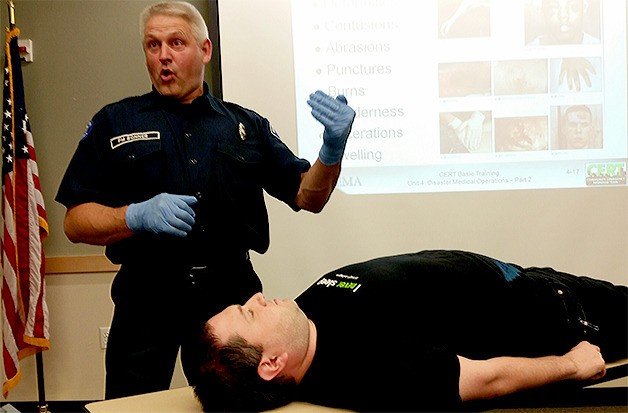Third in a series
MARYSVILLE – Our third Certified Emergency Response Training class focused on dealing with injuries in a disaster.
Steve Bonner, a firefighter-paramedic with the Marysville Fire Department, gave the presentation.
Public Health Considerations: To prevent the spread of disease, wash hands often, maintain proper sanitation, and purify water. If available, use hand sanitizer, non-latex gloves, N95 mask and goggles, keep dressings sterile and avoid contact with bodily fluids. Put waste in plastic bags, and bury human waste. Boil water for one minute, use water purification tablets, use eight drops of liquid bleach per gallon of water and wait 30 minutes before use.
Medical Treatment Area: Once you triage victims, treat them there if you can. But if there is any danger, they must be moved uphill and upwind from the tragedy. Think of a traffic light when sorting the victims by serious of injuries. Red is for those needing Immediate care, yellow for Delayed, green for Minor injuries and black for dead. Place the morgue out of site of the area where the others are being treated. Assign a treatment leader for each other, who will document as much as they can about the victims. Be descriptive to help medical personnel when they arrive.
Head-to-Toe assessment: This full body examination will determine the extent of injuries and type of treatment needed. Watch for deformities, contusions, abrasions, punctures, burns, tenderness, lacerations and swelling. Look, listen and feel. Check for pulse, motor skills and sensation. Check the head, neck, shoulders, chest, arms, abdomen, pelvis, legs and back. Stabilize the head and keep spine straight.
Treating burns: Cool the burned area, but not with ice. Cover with sterile cloth to reduce risk of infection, but don’t peel off skin or apply ointments. Keeping air from it reduces pain. Elevate burned extremities. Third-degree burns are the most serious. For chemical burns, remove the source of the burn, clothing, etc., and brush away if possible. Flush with lots of cool running water. Apply cool, wet compress to relieve pain.
Wound care: Control bleeding, clean wound, apply bandage. Clean with water, not hydrogen peroxide. If bleeding continues place new dressing over old, don’t take old off. Check for infection such as swelling, discoloration, discharge. If a limb is amputated, control the bleeding and save the body part in cool, clean material, but not on ice. Keep with victim for possible re-attachment. Leave impaled objects in the victim. Immobilize the body part and control the bleeding. Stabilize the impaled object, clean and dress the wound.
Fractures: Immobilize the area above and below the injury site. If it’s an open fracture where you can see the bone watch for infection. Cover wound with sterile dressing. Splint fracture without disturbing wound. Dislocations are injuries to ligaments around joints. Immobilize, do not try to re-set. Check pulse, motor skills and sensation before and after splinting. Sprains are swelling, bruising and tenderness at the site.
Splinting: Support area above and below injury. Use a blanket, magazine, pillow, cardboard, whatever you can, even the other leg or arm to keep it sturdy and in place. Split injury in position you find it. Don’t try to realign.
Nasal injuries: Blunt force to the nose can cause excessive bleeding and even skull fracture. Have the victim pinch their nose and lean forward. It could take a half hour to stop the bleeding.
Hypothermia: Symptoms include red or blue skin, numbness and shivering, slurred speech, unpredictable behavior, listlessness. To treat, remove wet clothes, wrap in blanket, protect victim from weather, place in warm bath if conscious, but do not massage to warm body. Frostbite symptoms include skin discoloration and numbness. To treat, immerse injured area in warm water, not hot. Warm slowly. Wrap with dry, sterile dressing.
Heat injuries: Occur due to lack of fluids in hot weather. Symptoms include heavy sweating, headache, nausea or vomiting, dizziness, exhaustion, pale skin. With heat stroke, skin is hot and red with a lack of perspiration. To treat, cool off the body and drink water slowly.
Steve Powell is the managing editor of The Marysville Globe-The Arlington Times. He is writing a column over the next several weeks so others can learn some basic things to do in the event of a disaster.



